BM533: Microeconomic Analysis of Demand, Supply, and Theories
VerifiedAdded on 2023/06/08
|15
|4275
|287
Report
AI Summary
This report, prepared for the BM533 Contemporary Business Economics module, delves into fundamental microeconomic concepts of demand and supply. Task 1 provides a detailed explanation of the law of demand, illustrating movements along and shifts in the demand curve, along with the factors that cause these changes, all with reference to Unilever and its products. Similarly, it explains the law of supply, the supply curve, and the factors influencing its shifts. Task 2 then compares and contrasts emerging economic theories and models of the 21st century with those of the 20th century, relating both to modern business practices. The report utilizes diagrams to illustrate the concepts and provides a comprehensive overview of the key principles of microeconomics and their relevance to contemporary business environments, drawing upon the case of Unilever. It provides a thorough examination of the subject matter, offering valuable insights into the application of economic principles in business decision-making.
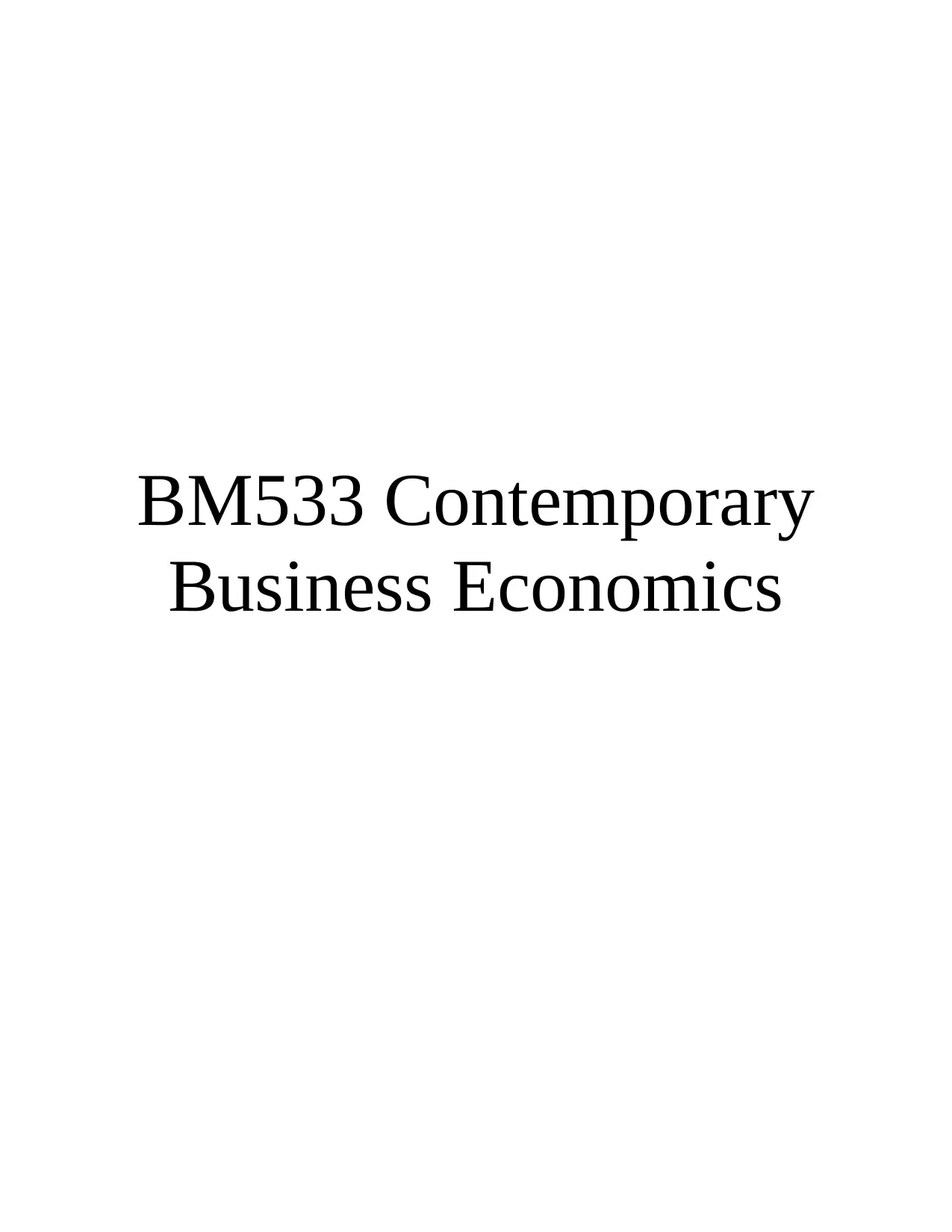
BM533 Contemporary
Business Economics
Business Economics
Paraphrase This Document
Need a fresh take? Get an instant paraphrase of this document with our AI Paraphraser
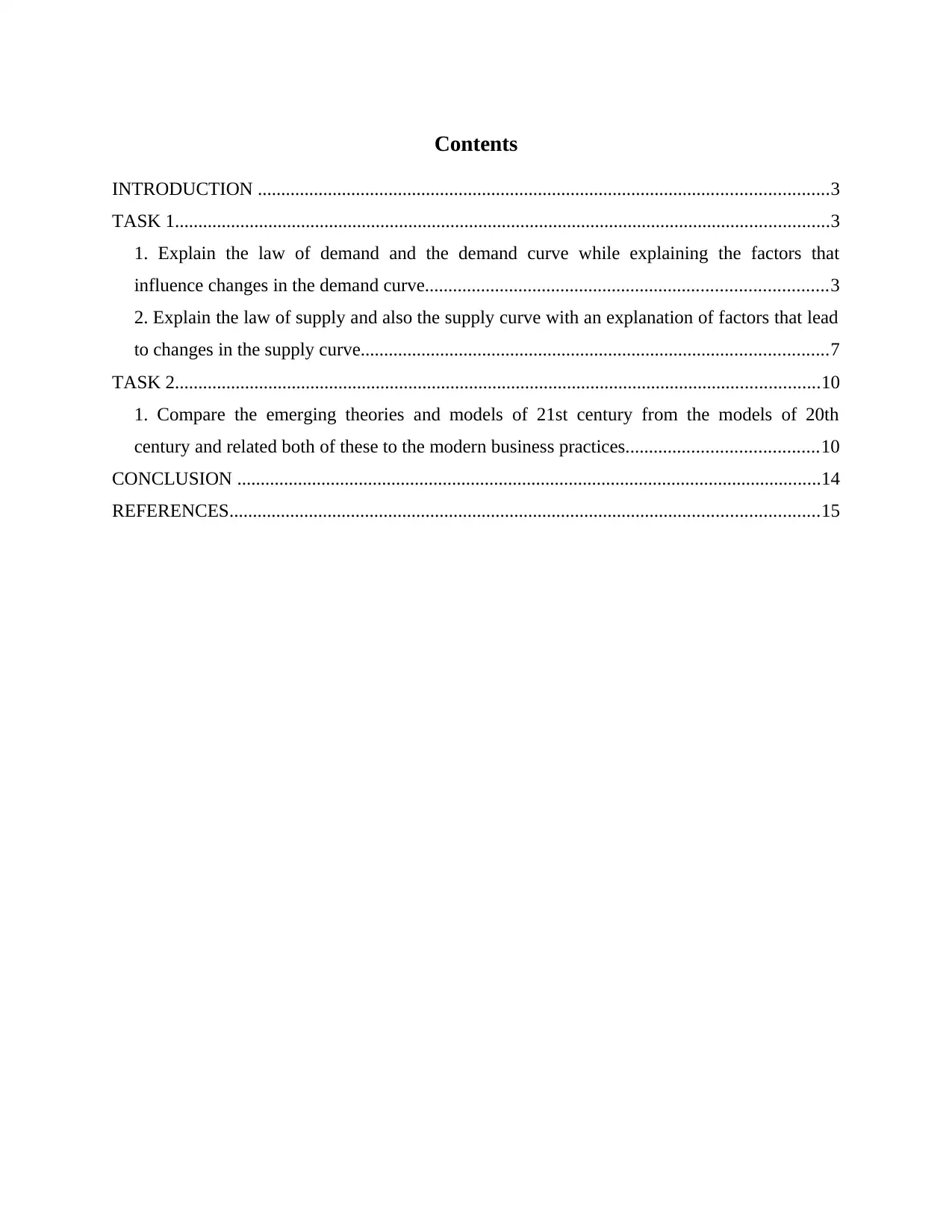
Contents
INTRODUCTION ..........................................................................................................................3
TASK 1............................................................................................................................................3
1. Explain the law of demand and the demand curve while explaining the factors that
influence changes in the demand curve......................................................................................3
2. Explain the law of supply and also the supply curve with an explanation of factors that lead
to changes in the supply curve....................................................................................................7
TASK 2..........................................................................................................................................10
1. Compare the emerging theories and models of 21st century from the models of 20th
century and related both of these to the modern business practices.........................................10
CONCLUSION .............................................................................................................................14
REFERENCES..............................................................................................................................15
INTRODUCTION ..........................................................................................................................3
TASK 1............................................................................................................................................3
1. Explain the law of demand and the demand curve while explaining the factors that
influence changes in the demand curve......................................................................................3
2. Explain the law of supply and also the supply curve with an explanation of factors that lead
to changes in the supply curve....................................................................................................7
TASK 2..........................................................................................................................................10
1. Compare the emerging theories and models of 21st century from the models of 20th
century and related both of these to the modern business practices.........................................10
CONCLUSION .............................................................................................................................14
REFERENCES..............................................................................................................................15
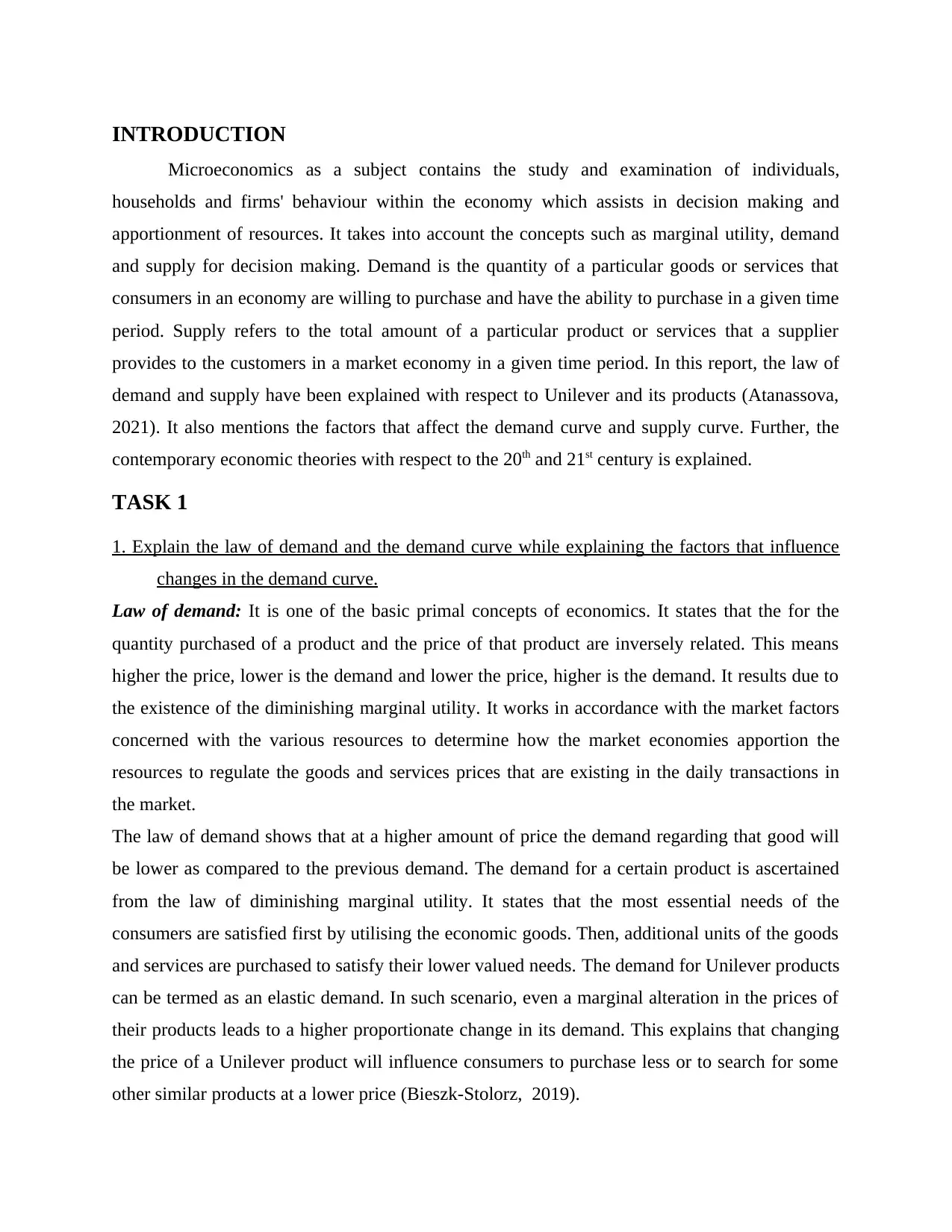
INTRODUCTION
Microeconomics as a subject contains the study and examination of individuals,
households and firms' behaviour within the economy which assists in decision making and
apportionment of resources. It takes into account the concepts such as marginal utility, demand
and supply for decision making. Demand is the quantity of a particular goods or services that
consumers in an economy are willing to purchase and have the ability to purchase in a given time
period. Supply refers to the total amount of a particular product or services that a supplier
provides to the customers in a market economy in a given time period. In this report, the law of
demand and supply have been explained with respect to Unilever and its products (Atanassova,
2021). It also mentions the factors that affect the demand curve and supply curve. Further, the
contemporary economic theories with respect to the 20th and 21st century is explained.
TASK 1
1. Explain the law of demand and the demand curve while explaining the factors that influence
changes in the demand curve.
Law of demand: It is one of the basic primal concepts of economics. It states that the for the
quantity purchased of a product and the price of that product are inversely related. This means
higher the price, lower is the demand and lower the price, higher is the demand. It results due to
the existence of the diminishing marginal utility. It works in accordance with the market factors
concerned with the various resources to determine how the market economies apportion the
resources to regulate the goods and services prices that are existing in the daily transactions in
the market.
The law of demand shows that at a higher amount of price the demand regarding that good will
be lower as compared to the previous demand. The demand for a certain product is ascertained
from the law of diminishing marginal utility. It states that the most essential needs of the
consumers are satisfied first by utilising the economic goods. Then, additional units of the goods
and services are purchased to satisfy their lower valued needs. The demand for Unilever products
can be termed as an elastic demand. In such scenario, even a marginal alteration in the prices of
their products leads to a higher proportionate change in its demand. This explains that changing
the price of a Unilever product will influence consumers to purchase less or to search for some
other similar products at a lower price (Bieszk-Stolorz, 2019).
Microeconomics as a subject contains the study and examination of individuals,
households and firms' behaviour within the economy which assists in decision making and
apportionment of resources. It takes into account the concepts such as marginal utility, demand
and supply for decision making. Demand is the quantity of a particular goods or services that
consumers in an economy are willing to purchase and have the ability to purchase in a given time
period. Supply refers to the total amount of a particular product or services that a supplier
provides to the customers in a market economy in a given time period. In this report, the law of
demand and supply have been explained with respect to Unilever and its products (Atanassova,
2021). It also mentions the factors that affect the demand curve and supply curve. Further, the
contemporary economic theories with respect to the 20th and 21st century is explained.
TASK 1
1. Explain the law of demand and the demand curve while explaining the factors that influence
changes in the demand curve.
Law of demand: It is one of the basic primal concepts of economics. It states that the for the
quantity purchased of a product and the price of that product are inversely related. This means
higher the price, lower is the demand and lower the price, higher is the demand. It results due to
the existence of the diminishing marginal utility. It works in accordance with the market factors
concerned with the various resources to determine how the market economies apportion the
resources to regulate the goods and services prices that are existing in the daily transactions in
the market.
The law of demand shows that at a higher amount of price the demand regarding that good will
be lower as compared to the previous demand. The demand for a certain product is ascertained
from the law of diminishing marginal utility. It states that the most essential needs of the
consumers are satisfied first by utilising the economic goods. Then, additional units of the goods
and services are purchased to satisfy their lower valued needs. The demand for Unilever products
can be termed as an elastic demand. In such scenario, even a marginal alteration in the prices of
their products leads to a higher proportionate change in its demand. This explains that changing
the price of a Unilever product will influence consumers to purchase less or to search for some
other similar products at a lower price (Bieszk-Stolorz, 2019).
⊘ This is a preview!⊘
Do you want full access?
Subscribe today to unlock all pages.

Trusted by 1+ million students worldwide
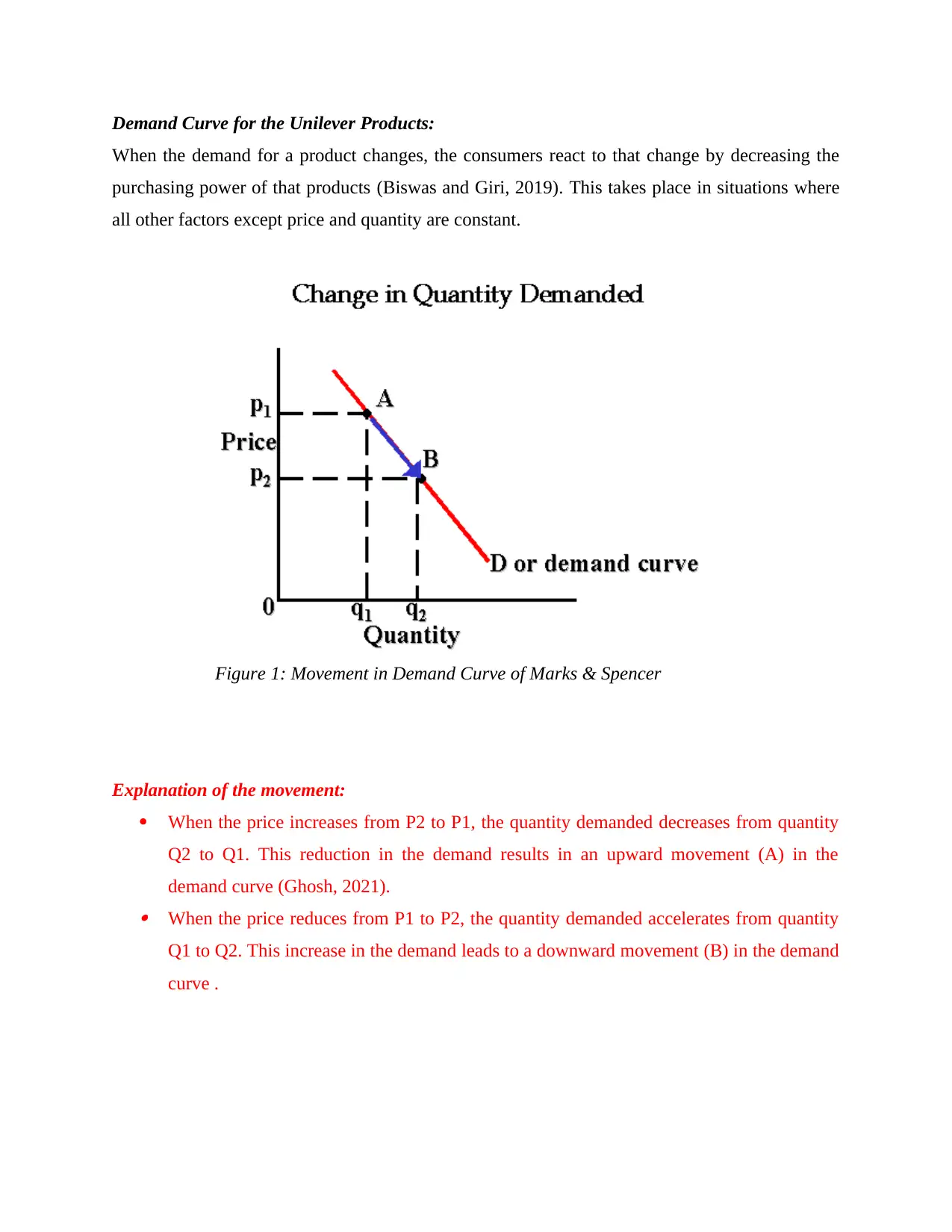
Demand Curve for the Unilever Products:
When the demand for a product changes, the consumers react to that change by decreasing the
purchasing power of that products (Biswas and Giri, 2019). This takes place in situations where
all other factors except price and quantity are constant.
Explanation of the movement:
When the price increases from P2 to P1, the quantity demanded decreases from quantity
Q2 to Q1. This reduction in the demand results in an upward movement (A) in the
demand curve (Ghosh, 2021). When the price reduces from P1 to P2, the quantity demanded accelerates from quantity
Q1 to Q2. This increase in the demand leads to a downward movement (B) in the demand
curve .
Figure 1: Movement in Demand Curve of Marks & Spencer
When the demand for a product changes, the consumers react to that change by decreasing the
purchasing power of that products (Biswas and Giri, 2019). This takes place in situations where
all other factors except price and quantity are constant.
Explanation of the movement:
When the price increases from P2 to P1, the quantity demanded decreases from quantity
Q2 to Q1. This reduction in the demand results in an upward movement (A) in the
demand curve (Ghosh, 2021). When the price reduces from P1 to P2, the quantity demanded accelerates from quantity
Q1 to Q2. This increase in the demand leads to a downward movement (B) in the demand
curve .
Figure 1: Movement in Demand Curve of Marks & Spencer
Paraphrase This Document
Need a fresh take? Get an instant paraphrase of this document with our AI Paraphraser
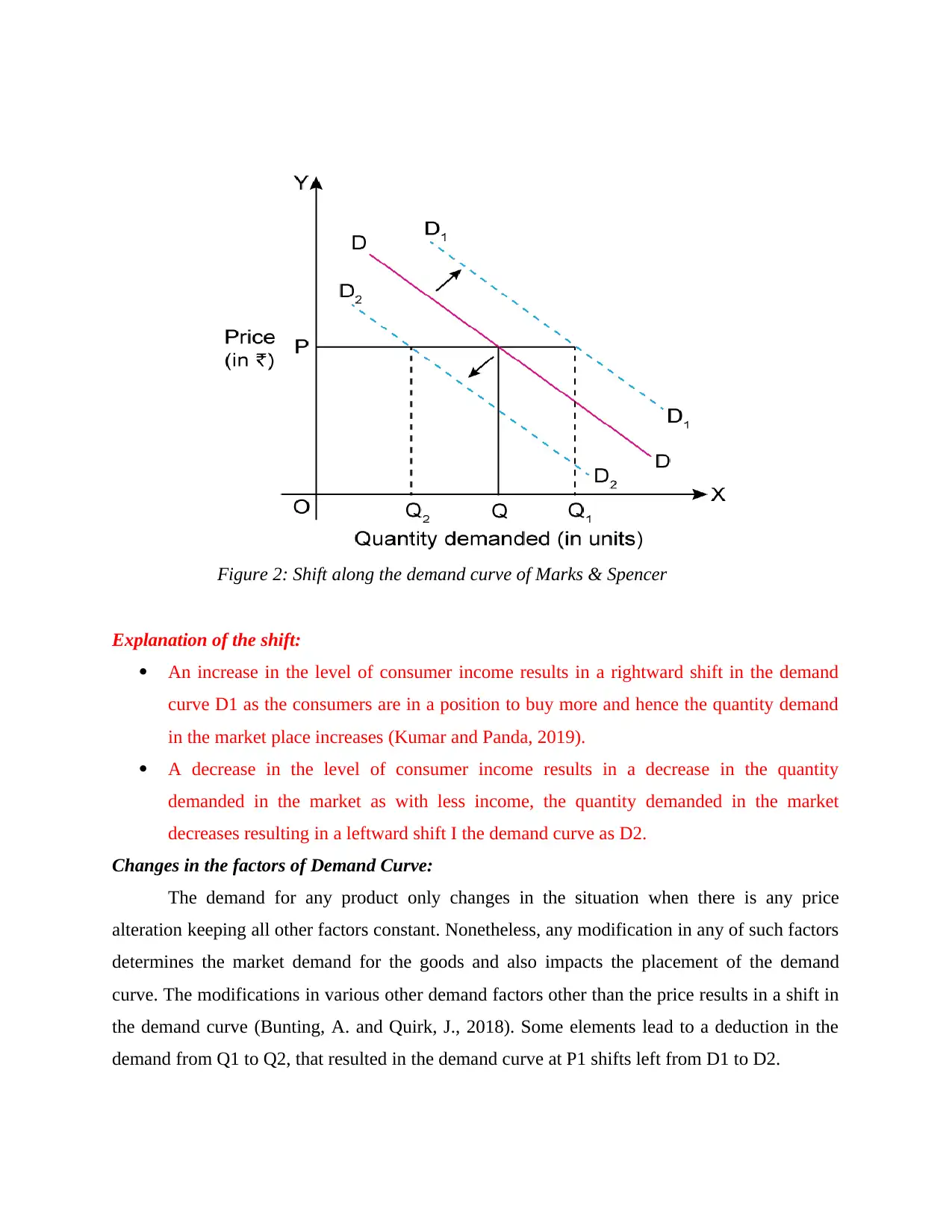
Explanation of the shift:
An increase in the level of consumer income results in a rightward shift in the demand
curve D1 as the consumers are in a position to buy more and hence the quantity demand
in the market place increases (Kumar and Panda, 2019).
A decrease in the level of consumer income results in a decrease in the quantity
demanded in the market as with less income, the quantity demanded in the market
decreases resulting in a leftward shift I the demand curve as D2.
Changes in the factors of Demand Curve:
The demand for any product only changes in the situation when there is any price
alteration keeping all other factors constant. Nonetheless, any modification in any of such factors
determines the market demand for the goods and also impacts the placement of the demand
curve. The modifications in various other demand factors other than the price results in a shift in
the demand curve (Bunting, A. and Quirk, J., 2018). Some elements lead to a deduction in the
demand from Q1 to Q2, that resulted in the demand curve at P1 shifts left from D1 to D2.
Figure 2: Shift along the demand curve of Marks & Spencer
An increase in the level of consumer income results in a rightward shift in the demand
curve D1 as the consumers are in a position to buy more and hence the quantity demand
in the market place increases (Kumar and Panda, 2019).
A decrease in the level of consumer income results in a decrease in the quantity
demanded in the market as with less income, the quantity demanded in the market
decreases resulting in a leftward shift I the demand curve as D2.
Changes in the factors of Demand Curve:
The demand for any product only changes in the situation when there is any price
alteration keeping all other factors constant. Nonetheless, any modification in any of such factors
determines the market demand for the goods and also impacts the placement of the demand
curve. The modifications in various other demand factors other than the price results in a shift in
the demand curve (Bunting, A. and Quirk, J., 2018). Some elements lead to a deduction in the
demand from Q1 to Q2, that resulted in the demand curve at P1 shifts left from D1 to D2.
Figure 2: Shift along the demand curve of Marks & Spencer
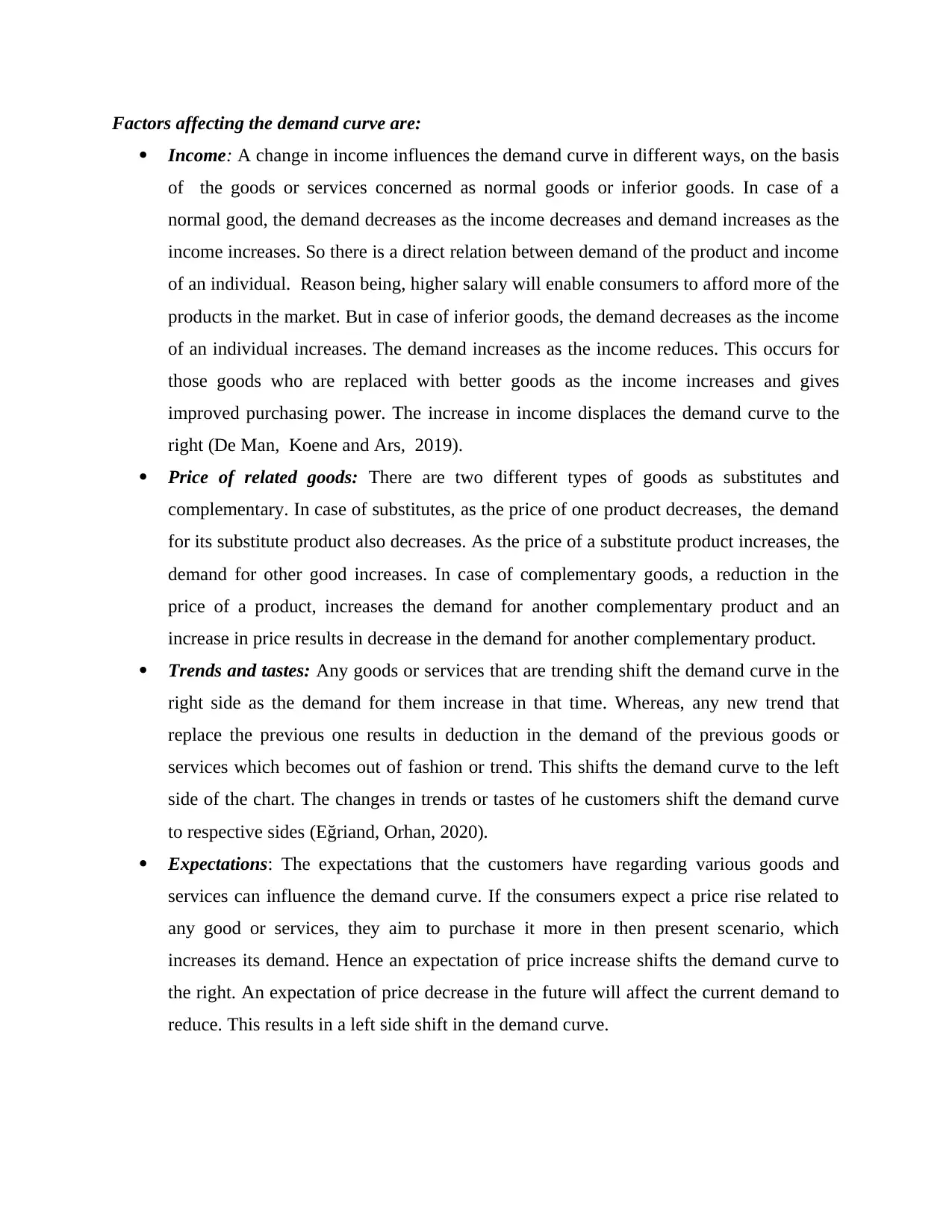
Factors affecting the demand curve are:
Income: A change in income influences the demand curve in different ways, on the basis
of the goods or services concerned as normal goods or inferior goods. In case of a
normal good, the demand decreases as the income decreases and demand increases as the
income increases. So there is a direct relation between demand of the product and income
of an individual. Reason being, higher salary will enable consumers to afford more of the
products in the market. But in case of inferior goods, the demand decreases as the income
of an individual increases. The demand increases as the income reduces. This occurs for
those goods who are replaced with better goods as the income increases and gives
improved purchasing power. The increase in income displaces the demand curve to the
right (De Man, Koene and Ars, 2019).
Price of related goods: There are two different types of goods as substitutes and
complementary. In case of substitutes, as the price of one product decreases, the demand
for its substitute product also decreases. As the price of a substitute product increases, the
demand for other good increases. In case of complementary goods, a reduction in the
price of a product, increases the demand for another complementary product and an
increase in price results in decrease in the demand for another complementary product.
Trends and tastes: Any goods or services that are trending shift the demand curve in the
right side as the demand for them increase in that time. Whereas, any new trend that
replace the previous one results in deduction in the demand of the previous goods or
services which becomes out of fashion or trend. This shifts the demand curve to the left
side of the chart. The changes in trends or tastes of he customers shift the demand curve
to respective sides (Eğriand, Orhan, 2020).
Expectations: The expectations that the customers have regarding various goods and
services can influence the demand curve. If the consumers expect a price rise related to
any good or services, they aim to purchase it more in then present scenario, which
increases its demand. Hence an expectation of price increase shifts the demand curve to
the right. An expectation of price decrease in the future will affect the current demand to
reduce. This results in a left side shift in the demand curve.
Income: A change in income influences the demand curve in different ways, on the basis
of the goods or services concerned as normal goods or inferior goods. In case of a
normal good, the demand decreases as the income decreases and demand increases as the
income increases. So there is a direct relation between demand of the product and income
of an individual. Reason being, higher salary will enable consumers to afford more of the
products in the market. But in case of inferior goods, the demand decreases as the income
of an individual increases. The demand increases as the income reduces. This occurs for
those goods who are replaced with better goods as the income increases and gives
improved purchasing power. The increase in income displaces the demand curve to the
right (De Man, Koene and Ars, 2019).
Price of related goods: There are two different types of goods as substitutes and
complementary. In case of substitutes, as the price of one product decreases, the demand
for its substitute product also decreases. As the price of a substitute product increases, the
demand for other good increases. In case of complementary goods, a reduction in the
price of a product, increases the demand for another complementary product and an
increase in price results in decrease in the demand for another complementary product.
Trends and tastes: Any goods or services that are trending shift the demand curve in the
right side as the demand for them increase in that time. Whereas, any new trend that
replace the previous one results in deduction in the demand of the previous goods or
services which becomes out of fashion or trend. This shifts the demand curve to the left
side of the chart. The changes in trends or tastes of he customers shift the demand curve
to respective sides (Eğriand, Orhan, 2020).
Expectations: The expectations that the customers have regarding various goods and
services can influence the demand curve. If the consumers expect a price rise related to
any good or services, they aim to purchase it more in then present scenario, which
increases its demand. Hence an expectation of price increase shifts the demand curve to
the right. An expectation of price decrease in the future will affect the current demand to
reduce. This results in a left side shift in the demand curve.
⊘ This is a preview!⊘
Do you want full access?
Subscribe today to unlock all pages.

Trusted by 1+ million students worldwide
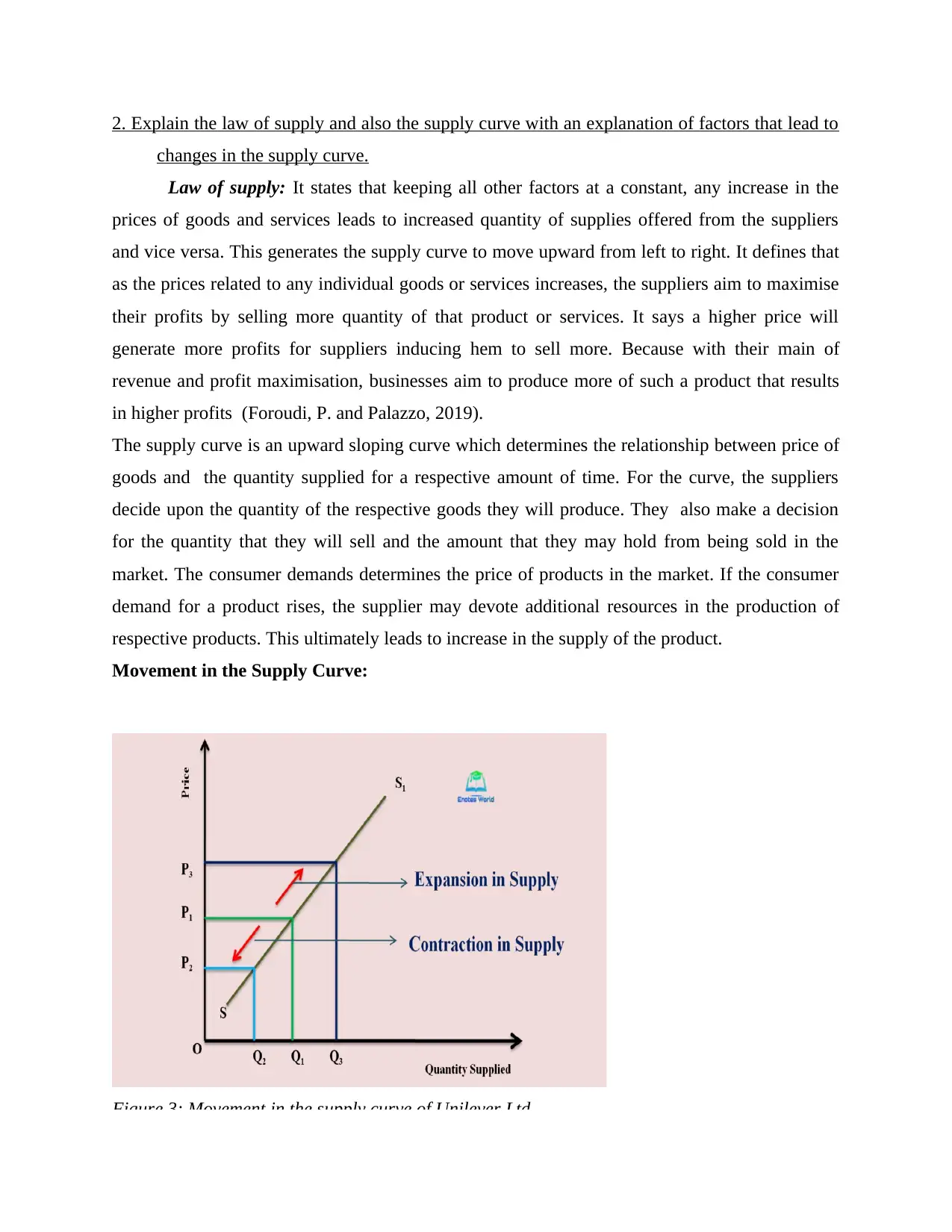
2. Explain the law of supply and also the supply curve with an explanation of factors that lead to
changes in the supply curve.
Law of supply: It states that keeping all other factors at a constant, any increase in the
prices of goods and services leads to increased quantity of supplies offered from the suppliers
and vice versa. This generates the supply curve to move upward from left to right. It defines that
as the prices related to any individual goods or services increases, the suppliers aim to maximise
their profits by selling more quantity of that product or services. It says a higher price will
generate more profits for suppliers inducing hem to sell more. Because with their main of
revenue and profit maximisation, businesses aim to produce more of such a product that results
in higher profits (Foroudi, P. and Palazzo, 2019).
The supply curve is an upward sloping curve which determines the relationship between price of
goods and the quantity supplied for a respective amount of time. For the curve, the suppliers
decide upon the quantity of the respective goods they will produce. They also make a decision
for the quantity that they will sell and the amount that they may hold from being sold in the
market. The consumer demands determines the price of products in the market. If the consumer
demand for a product rises, the supplier may devote additional resources in the production of
respective products. This ultimately leads to increase in the supply of the product.
Movement in the Supply Curve:
Figure 3: Movement in the supply curve of Unilever Ltd.
changes in the supply curve.
Law of supply: It states that keeping all other factors at a constant, any increase in the
prices of goods and services leads to increased quantity of supplies offered from the suppliers
and vice versa. This generates the supply curve to move upward from left to right. It defines that
as the prices related to any individual goods or services increases, the suppliers aim to maximise
their profits by selling more quantity of that product or services. It says a higher price will
generate more profits for suppliers inducing hem to sell more. Because with their main of
revenue and profit maximisation, businesses aim to produce more of such a product that results
in higher profits (Foroudi, P. and Palazzo, 2019).
The supply curve is an upward sloping curve which determines the relationship between price of
goods and the quantity supplied for a respective amount of time. For the curve, the suppliers
decide upon the quantity of the respective goods they will produce. They also make a decision
for the quantity that they will sell and the amount that they may hold from being sold in the
market. The consumer demands determines the price of products in the market. If the consumer
demand for a product rises, the supplier may devote additional resources in the production of
respective products. This ultimately leads to increase in the supply of the product.
Movement in the Supply Curve:
Figure 3: Movement in the supply curve of Unilever Ltd.
Paraphrase This Document
Need a fresh take? Get an instant paraphrase of this document with our AI Paraphraser
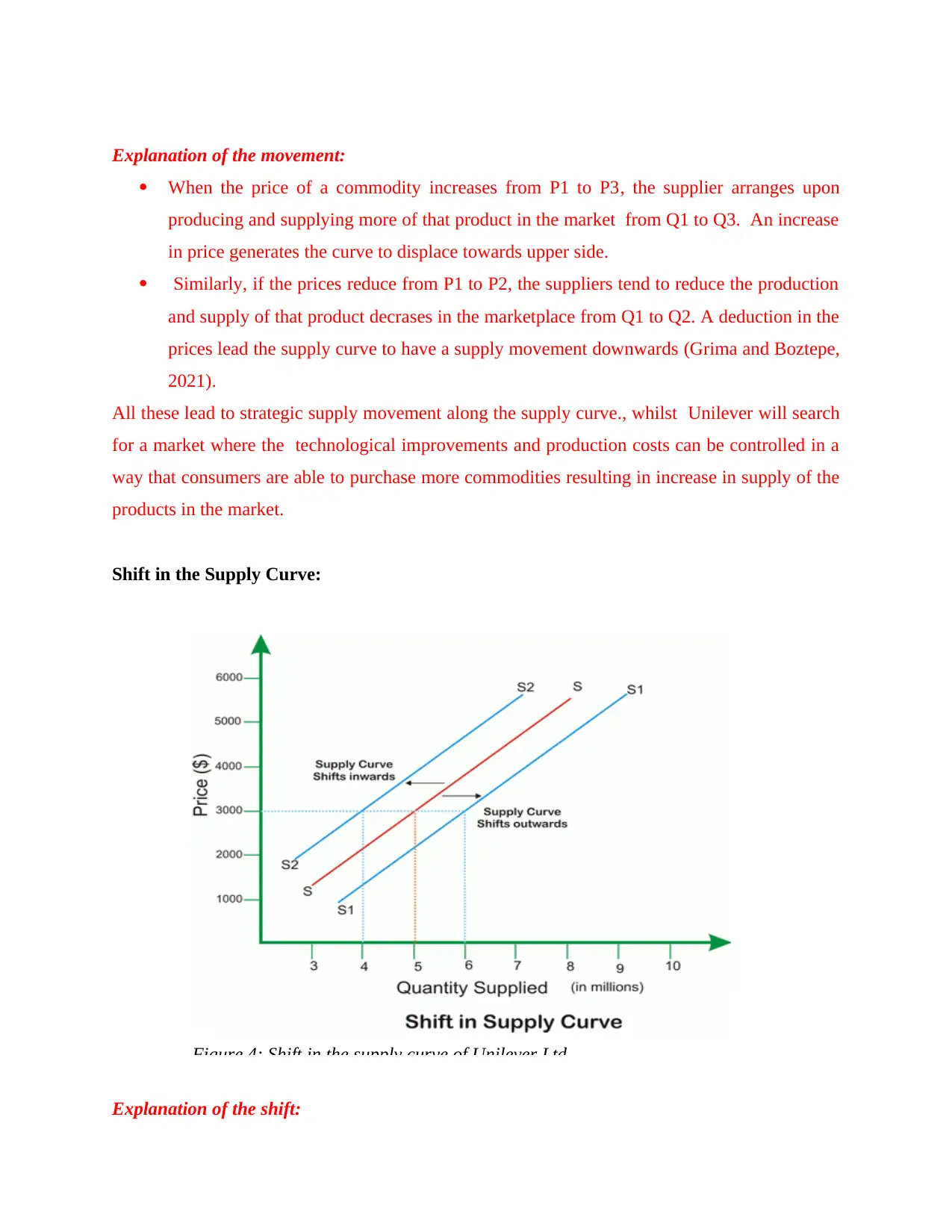
Explanation of the movement:
When the price of a commodity increases from P1 to P3, the supplier arranges upon
producing and supplying more of that product in the market from Q1 to Q3. An increase
in price generates the curve to displace towards upper side.
Similarly, if the prices reduce from P1 to P2, the suppliers tend to reduce the production
and supply of that product decrases in the marketplace from Q1 to Q2. A deduction in the
prices lead the supply curve to have a supply movement downwards (Grima and Boztepe,
2021).
All these lead to strategic supply movement along the supply curve., whilst Unilever will search
for a market where the technological improvements and production costs can be controlled in a
way that consumers are able to purchase more commodities resulting in increase in supply of the
products in the market.
Shift in the Supply Curve:
Explanation of the shift:
Figure 4: Shift in the supply curve of Unilever Ltd.
When the price of a commodity increases from P1 to P3, the supplier arranges upon
producing and supplying more of that product in the market from Q1 to Q3. An increase
in price generates the curve to displace towards upper side.
Similarly, if the prices reduce from P1 to P2, the suppliers tend to reduce the production
and supply of that product decrases in the marketplace from Q1 to Q2. A deduction in the
prices lead the supply curve to have a supply movement downwards (Grima and Boztepe,
2021).
All these lead to strategic supply movement along the supply curve., whilst Unilever will search
for a market where the technological improvements and production costs can be controlled in a
way that consumers are able to purchase more commodities resulting in increase in supply of the
products in the market.
Shift in the Supply Curve:
Explanation of the shift:
Figure 4: Shift in the supply curve of Unilever Ltd.
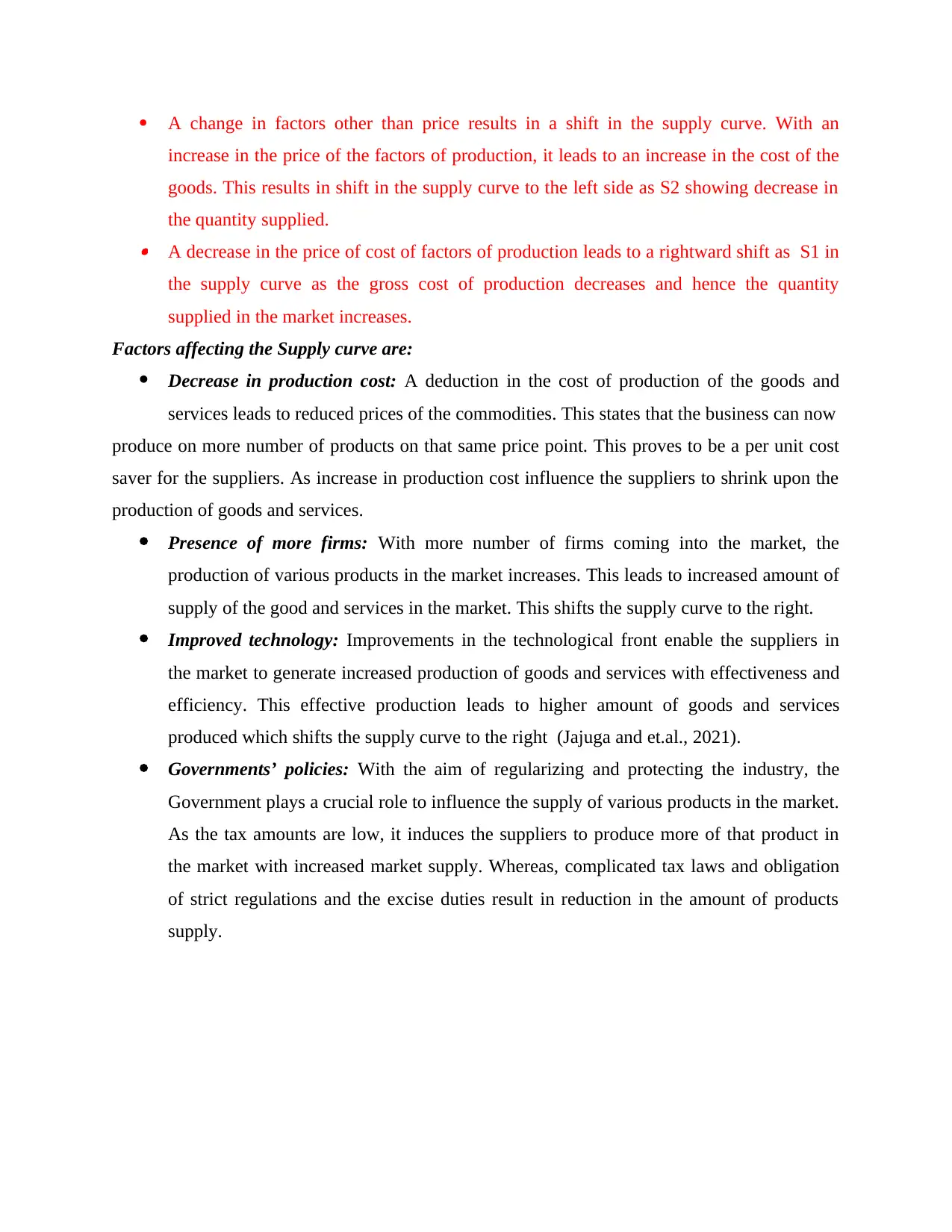
A change in factors other than price results in a shift in the supply curve. With an
increase in the price of the factors of production, it leads to an increase in the cost of the
goods. This results in shift in the supply curve to the left side as S2 showing decrease in
the quantity supplied. A decrease in the price of cost of factors of production leads to a rightward shift as S1 in
the supply curve as the gross cost of production decreases and hence the quantity
supplied in the market increases.
Factors affecting the Supply curve are:
Decrease in production cost: A deduction in the cost of production of the goods and
services leads to reduced prices of the commodities. This states that the business can now
produce on more number of products on that same price point. This proves to be a per unit cost
saver for the suppliers. As increase in production cost influence the suppliers to shrink upon the
production of goods and services.
Presence of more firms: With more number of firms coming into the market, the
production of various products in the market increases. This leads to increased amount of
supply of the good and services in the market. This shifts the supply curve to the right.
Improved technology: Improvements in the technological front enable the suppliers in
the market to generate increased production of goods and services with effectiveness and
efficiency. This effective production leads to higher amount of goods and services
produced which shifts the supply curve to the right (Jajuga and et.al., 2021).
Governments’ policies: With the aim of regularizing and protecting the industry, the
Government plays a crucial role to influence the supply of various products in the market.
As the tax amounts are low, it induces the suppliers to produce more of that product in
the market with increased market supply. Whereas, complicated tax laws and obligation
of strict regulations and the excise duties result in reduction in the amount of products
supply.
increase in the price of the factors of production, it leads to an increase in the cost of the
goods. This results in shift in the supply curve to the left side as S2 showing decrease in
the quantity supplied. A decrease in the price of cost of factors of production leads to a rightward shift as S1 in
the supply curve as the gross cost of production decreases and hence the quantity
supplied in the market increases.
Factors affecting the Supply curve are:
Decrease in production cost: A deduction in the cost of production of the goods and
services leads to reduced prices of the commodities. This states that the business can now
produce on more number of products on that same price point. This proves to be a per unit cost
saver for the suppliers. As increase in production cost influence the suppliers to shrink upon the
production of goods and services.
Presence of more firms: With more number of firms coming into the market, the
production of various products in the market increases. This leads to increased amount of
supply of the good and services in the market. This shifts the supply curve to the right.
Improved technology: Improvements in the technological front enable the suppliers in
the market to generate increased production of goods and services with effectiveness and
efficiency. This effective production leads to higher amount of goods and services
produced which shifts the supply curve to the right (Jajuga and et.al., 2021).
Governments’ policies: With the aim of regularizing and protecting the industry, the
Government plays a crucial role to influence the supply of various products in the market.
As the tax amounts are low, it induces the suppliers to produce more of that product in
the market with increased market supply. Whereas, complicated tax laws and obligation
of strict regulations and the excise duties result in reduction in the amount of products
supply.
⊘ This is a preview!⊘
Do you want full access?
Subscribe today to unlock all pages.

Trusted by 1+ million students worldwide
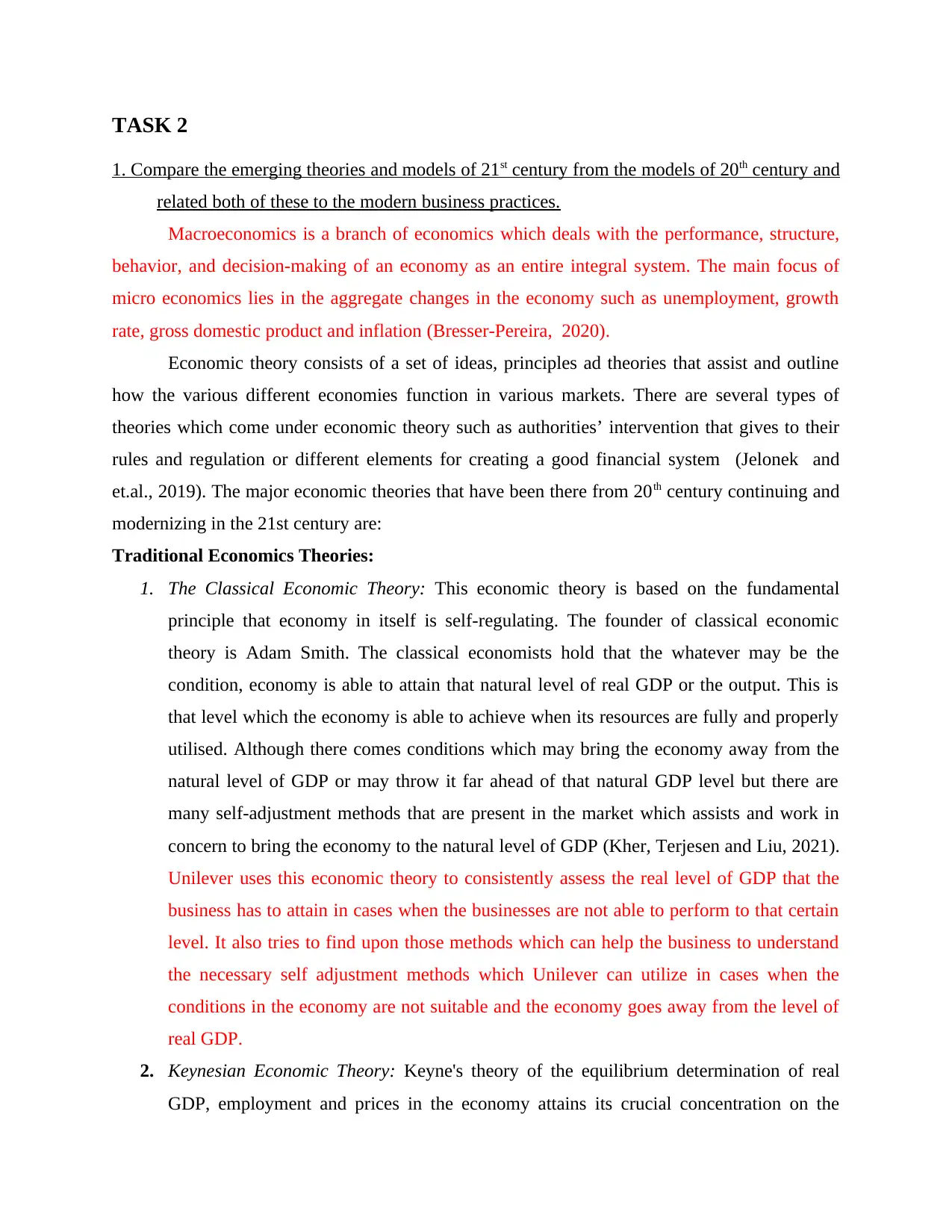
TASK 2
1. Compare the emerging theories and models of 21st century from the models of 20th century and
related both of these to the modern business practices.
Macroeconomics is a branch of economics which deals with the performance, structure,
behavior, and decision-making of an economy as an entire integral system. The main focus of
micro economics lies in the aggregate changes in the economy such as unemployment, growth
rate, gross domestic product and inflation (Bresser-Pereira, 2020).
Economic theory consists of a set of ideas, principles ad theories that assist and outline
how the various different economies function in various markets. There are several types of
theories which come under economic theory such as authorities’ intervention that gives to their
rules and regulation or different elements for creating a good financial system (Jelonek and
et.al., 2019). The major economic theories that have been there from 20th century continuing and
modernizing in the 21st century are:
Traditional Economics Theories:
1. The Classical Economic Theory: This economic theory is based on the fundamental
principle that economy in itself is self-regulating. The founder of classical economic
theory is Adam Smith. The classical economists hold that the whatever may be the
condition, economy is able to attain that natural level of real GDP or the output. This is
that level which the economy is able to achieve when its resources are fully and properly
utilised. Although there comes conditions which may bring the economy away from the
natural level of GDP or may throw it far ahead of that natural GDP level but there are
many self‐adjustment methods that are present in the market which assists and work in
concern to bring the economy to the natural level of GDP (Kher, Terjesen and Liu, 2021).
Unilever uses this economic theory to consistently assess the real level of GDP that the
business has to attain in cases when the businesses are not able to perform to that certain
level. It also tries to find upon those methods which can help the business to understand
the necessary self adjustment methods which Unilever can utilize in cases when the
conditions in the economy are not suitable and the economy goes away from the level of
real GDP.
2. Keynesian Economic Theory: Keyne's theory of the equilibrium determination of real
GDP, employment and prices in the economy attains its crucial concentration on the
1. Compare the emerging theories and models of 21st century from the models of 20th century and
related both of these to the modern business practices.
Macroeconomics is a branch of economics which deals with the performance, structure,
behavior, and decision-making of an economy as an entire integral system. The main focus of
micro economics lies in the aggregate changes in the economy such as unemployment, growth
rate, gross domestic product and inflation (Bresser-Pereira, 2020).
Economic theory consists of a set of ideas, principles ad theories that assist and outline
how the various different economies function in various markets. There are several types of
theories which come under economic theory such as authorities’ intervention that gives to their
rules and regulation or different elements for creating a good financial system (Jelonek and
et.al., 2019). The major economic theories that have been there from 20th century continuing and
modernizing in the 21st century are:
Traditional Economics Theories:
1. The Classical Economic Theory: This economic theory is based on the fundamental
principle that economy in itself is self-regulating. The founder of classical economic
theory is Adam Smith. The classical economists hold that the whatever may be the
condition, economy is able to attain that natural level of real GDP or the output. This is
that level which the economy is able to achieve when its resources are fully and properly
utilised. Although there comes conditions which may bring the economy away from the
natural level of GDP or may throw it far ahead of that natural GDP level but there are
many self‐adjustment methods that are present in the market which assists and work in
concern to bring the economy to the natural level of GDP (Kher, Terjesen and Liu, 2021).
Unilever uses this economic theory to consistently assess the real level of GDP that the
business has to attain in cases when the businesses are not able to perform to that certain
level. It also tries to find upon those methods which can help the business to understand
the necessary self adjustment methods which Unilever can utilize in cases when the
conditions in the economy are not suitable and the economy goes away from the level of
real GDP.
2. Keynesian Economic Theory: Keyne's theory of the equilibrium determination of real
GDP, employment and prices in the economy attains its crucial concentration on the
Paraphrase This Document
Need a fresh take? Get an instant paraphrase of this document with our AI Paraphraser
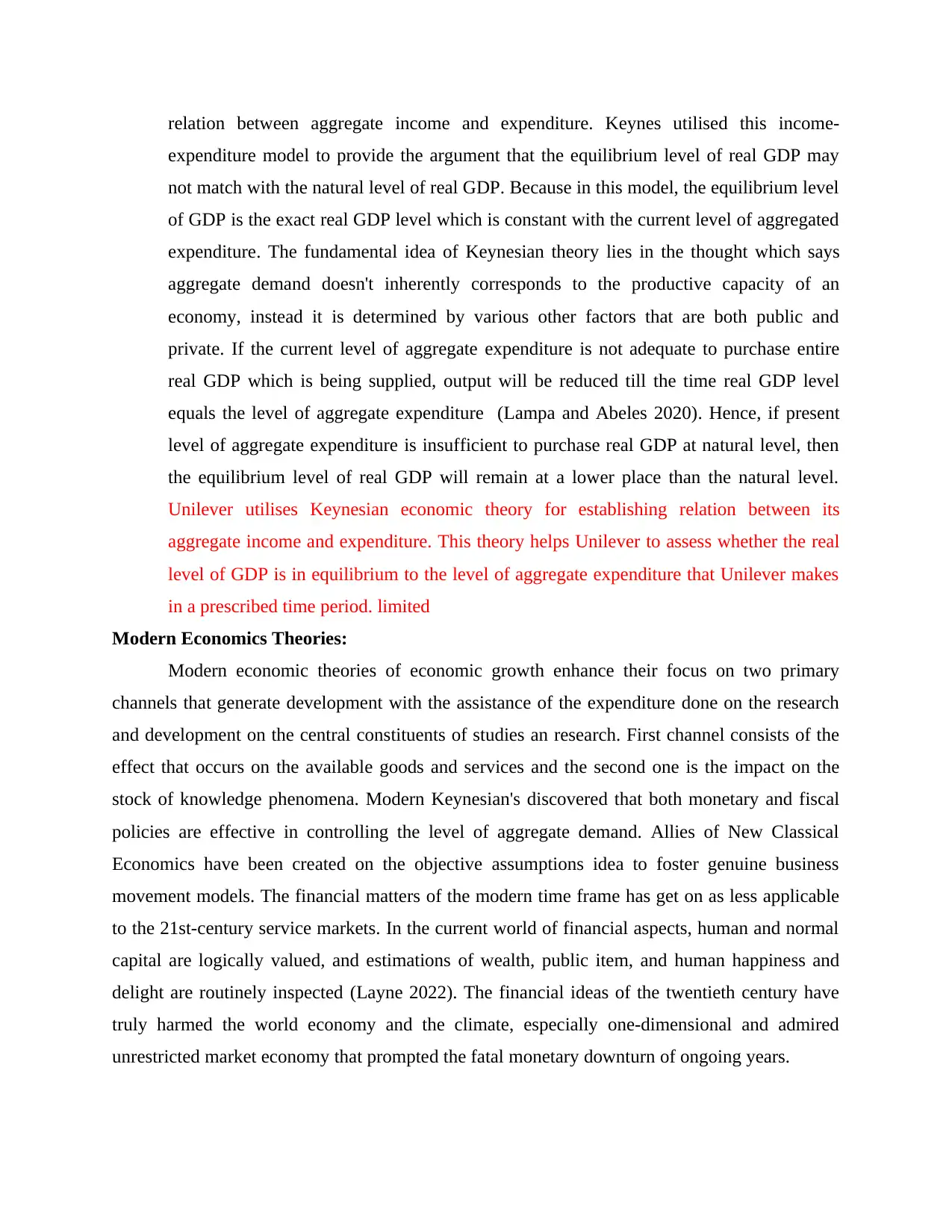
relation between aggregate income and expenditure. Keynes utilised this income-
expenditure model to provide the argument that the equilibrium level of real GDP may
not match with the natural level of real GDP. Because in this model, the equilibrium level
of GDP is the exact real GDP level which is constant with the current level of aggregated
expenditure. The fundamental idea of Keynesian theory lies in the thought which says
aggregate demand doesn't inherently corresponds to the productive capacity of an
economy, instead it is determined by various other factors that are both public and
private. If the current level of aggregate expenditure is not adequate to purchase entire
real GDP which is being supplied, output will be reduced till the time real GDP level
equals the level of aggregate expenditure (Lampa and Abeles 2020). Hence, if present
level of aggregate expenditure is insufficient to purchase real GDP at natural level, then
the equilibrium level of real GDP will remain at a lower place than the natural level.
Unilever utilises Keynesian economic theory for establishing relation between its
aggregate income and expenditure. This theory helps Unilever to assess whether the real
level of GDP is in equilibrium to the level of aggregate expenditure that Unilever makes
in a prescribed time period. limited
Modern Economics Theories:
Modern economic theories of economic growth enhance their focus on two primary
channels that generate development with the assistance of the expenditure done on the research
and development on the central constituents of studies an research. First channel consists of the
effect that occurs on the available goods and services and the second one is the impact on the
stock of knowledge phenomena. Modern Keynesian's discovered that both monetary and fiscal
policies are effective in controlling the level of aggregate demand. Allies of New Classical
Economics have been created on the objective assumptions idea to foster genuine business
movement models. The financial matters of the modern time frame has get on as less applicable
to the 21st-century service markets. In the current world of financial aspects, human and normal
capital are logically valued, and estimations of wealth, public item, and human happiness and
delight are routinely inspected (Layne 2022). The financial ideas of the twentieth century have
truly harmed the world economy and the climate, especially one-dimensional and admired
unrestricted market economy that prompted the fatal monetary downturn of ongoing years.
expenditure model to provide the argument that the equilibrium level of real GDP may
not match with the natural level of real GDP. Because in this model, the equilibrium level
of GDP is the exact real GDP level which is constant with the current level of aggregated
expenditure. The fundamental idea of Keynesian theory lies in the thought which says
aggregate demand doesn't inherently corresponds to the productive capacity of an
economy, instead it is determined by various other factors that are both public and
private. If the current level of aggregate expenditure is not adequate to purchase entire
real GDP which is being supplied, output will be reduced till the time real GDP level
equals the level of aggregate expenditure (Lampa and Abeles 2020). Hence, if present
level of aggregate expenditure is insufficient to purchase real GDP at natural level, then
the equilibrium level of real GDP will remain at a lower place than the natural level.
Unilever utilises Keynesian economic theory for establishing relation between its
aggregate income and expenditure. This theory helps Unilever to assess whether the real
level of GDP is in equilibrium to the level of aggregate expenditure that Unilever makes
in a prescribed time period. limited
Modern Economics Theories:
Modern economic theories of economic growth enhance their focus on two primary
channels that generate development with the assistance of the expenditure done on the research
and development on the central constituents of studies an research. First channel consists of the
effect that occurs on the available goods and services and the second one is the impact on the
stock of knowledge phenomena. Modern Keynesian's discovered that both monetary and fiscal
policies are effective in controlling the level of aggregate demand. Allies of New Classical
Economics have been created on the objective assumptions idea to foster genuine business
movement models. The financial matters of the modern time frame has get on as less applicable
to the 21st-century service markets. In the current world of financial aspects, human and normal
capital are logically valued, and estimations of wealth, public item, and human happiness and
delight are routinely inspected (Layne 2022). The financial ideas of the twentieth century have
truly harmed the world economy and the climate, especially one-dimensional and admired
unrestricted market economy that prompted the fatal monetary downturn of ongoing years.
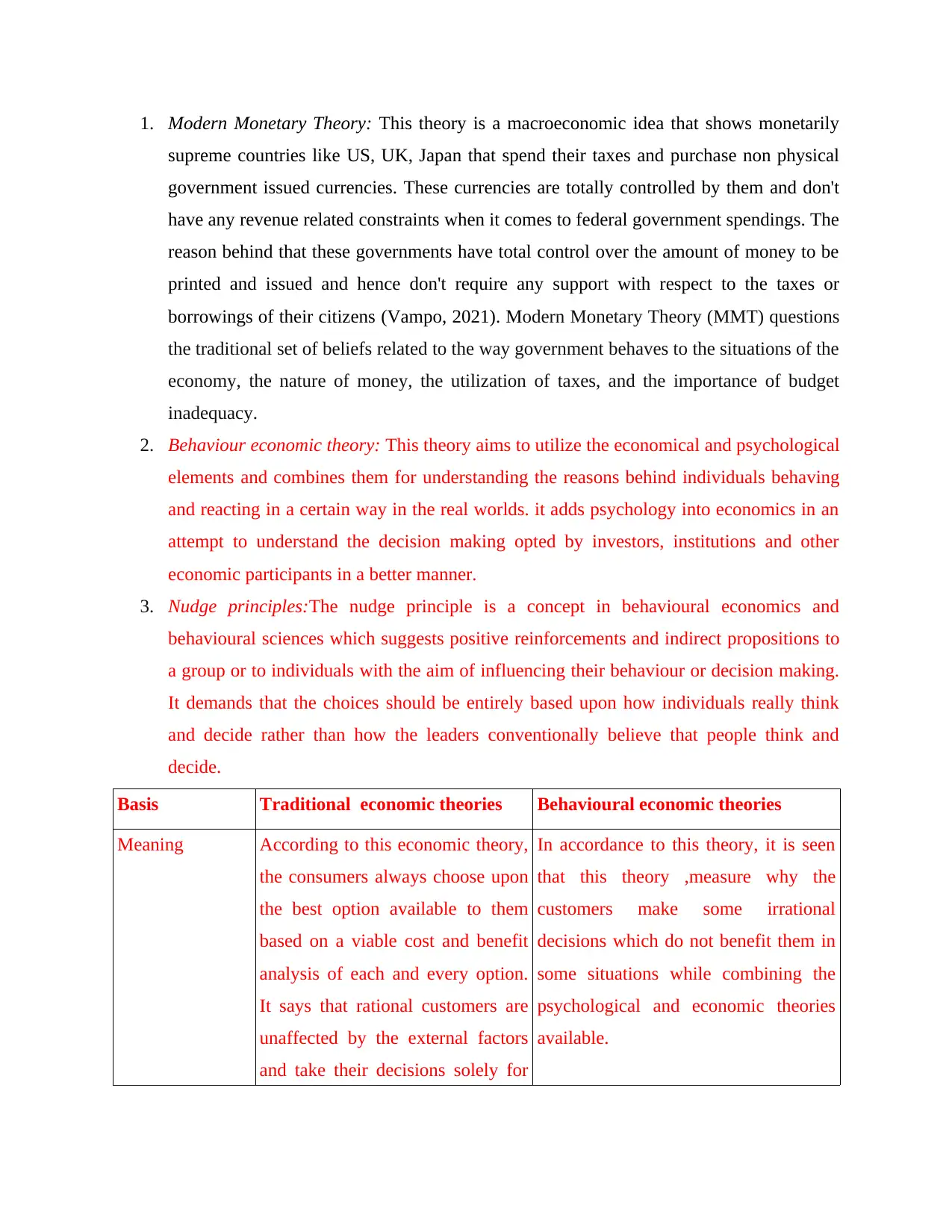
1. Modern Monetary Theory: This theory is a macroeconomic idea that shows monetarily
supreme countries like US, UK, Japan that spend their taxes and purchase non physical
government issued currencies. These currencies are totally controlled by them and don't
have any revenue related constraints when it comes to federal government spendings. The
reason behind that these governments have total control over the amount of money to be
printed and issued and hence don't require any support with respect to the taxes or
borrowings of their citizens (Vampo, 2021). Modern Monetary Theory (MMT) questions
the traditional set of beliefs related to the way government behaves to the situations of the
economy, the nature of money, the utilization of taxes, and the importance of budget
inadequacy.
2. Behaviour economic theory: This theory aims to utilize the economical and psychological
elements and combines them for understanding the reasons behind individuals behaving
and reacting in a certain way in the real worlds. it adds psychology into economics in an
attempt to understand the decision making opted by investors, institutions and other
economic participants in a better manner.
3. Nudge principles:The nudge principle is a concept in behavioural economics and
behavioural sciences which suggests positive reinforcements and indirect propositions to
a group or to individuals with the aim of influencing their behaviour or decision making.
It demands that the choices should be entirely based upon how individuals really think
and decide rather than how the leaders conventionally believe that people think and
decide.
Basis Traditional economic theories Behavioural economic theories
Meaning According to this economic theory,
the consumers always choose upon
the best option available to them
based on a viable cost and benefit
analysis of each and every option.
It says that rational customers are
unaffected by the external factors
and take their decisions solely for
In accordance to this theory, it is seen
that this theory ,measure why the
customers make some irrational
decisions which do not benefit them in
some situations while combining the
psychological and economic theories
available.
supreme countries like US, UK, Japan that spend their taxes and purchase non physical
government issued currencies. These currencies are totally controlled by them and don't
have any revenue related constraints when it comes to federal government spendings. The
reason behind that these governments have total control over the amount of money to be
printed and issued and hence don't require any support with respect to the taxes or
borrowings of their citizens (Vampo, 2021). Modern Monetary Theory (MMT) questions
the traditional set of beliefs related to the way government behaves to the situations of the
economy, the nature of money, the utilization of taxes, and the importance of budget
inadequacy.
2. Behaviour economic theory: This theory aims to utilize the economical and psychological
elements and combines them for understanding the reasons behind individuals behaving
and reacting in a certain way in the real worlds. it adds psychology into economics in an
attempt to understand the decision making opted by investors, institutions and other
economic participants in a better manner.
3. Nudge principles:The nudge principle is a concept in behavioural economics and
behavioural sciences which suggests positive reinforcements and indirect propositions to
a group or to individuals with the aim of influencing their behaviour or decision making.
It demands that the choices should be entirely based upon how individuals really think
and decide rather than how the leaders conventionally believe that people think and
decide.
Basis Traditional economic theories Behavioural economic theories
Meaning According to this economic theory,
the consumers always choose upon
the best option available to them
based on a viable cost and benefit
analysis of each and every option.
It says that rational customers are
unaffected by the external factors
and take their decisions solely for
In accordance to this theory, it is seen
that this theory ,measure why the
customers make some irrational
decisions which do not benefit them in
some situations while combining the
psychological and economic theories
available.
⊘ This is a preview!⊘
Do you want full access?
Subscribe today to unlock all pages.

Trusted by 1+ million students worldwide
1 out of 15
Related Documents
Your All-in-One AI-Powered Toolkit for Academic Success.
+13062052269
info@desklib.com
Available 24*7 on WhatsApp / Email
![[object Object]](/_next/static/media/star-bottom.7253800d.svg)
Unlock your academic potential
Copyright © 2020–2025 A2Z Services. All Rights Reserved. Developed and managed by ZUCOL.

